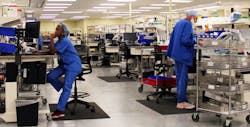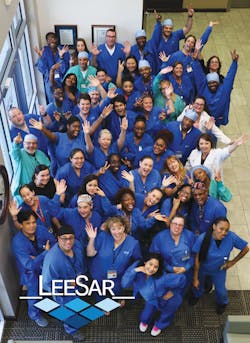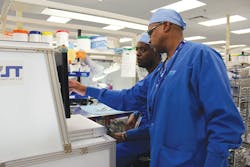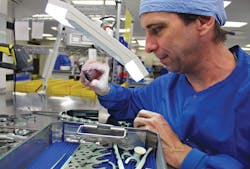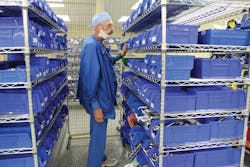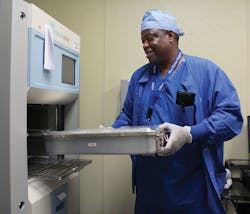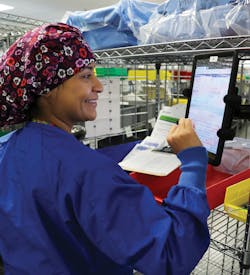Team LeeSar puts customers, patients first via Lean staff
Stride into the Sterile Processing wing of LeeSar Regional Service Center, Fort Myers, FL, and your gaze will be lured up to a sign suspended from the ceiling that reads in bold blue letters, “Surgery Starts Here!”
To some, the simple message may elicit a puzzled look as the hospital nearest to this off-site reprocessing facility operates roughly two miles away.
To others, the message can have a double meaning. After all, reprocessing devices and instruments represents a form of “surgery” on those products. But it also can mean that surgery cannot begin in the Operating Room until Sterile Processing & Distribution completed its job completely and safely.
Actually, the real story hovers somewhere in between. LeeSar CEO Bob Simpson
borrowed the idea for his team after seeing it used at another facility.
“The motivation behind the idea is to connect the SPD techs to the patient and our mission, especially since we are not in the hospital setting and do not see the OR, the OR staff, or the patients while working at our off-site reprocessing center at the LeeSar building,” Simpson said. “The [SPD] team is proud of what they do, and we talk about the patients each day with the great work done and any defects that may have occurred. The team talks about the impact to the patient and to the surgical team.”
Kimberly Blakey, RN, MSN, Executive Director of Sterile Processing, counts her team’s off-campus location more as a benefit than a liability for customer service and productivity.
“One of the biggest challenges with SPDs existing within the surgical department is distractions,” Blakey told Healthcare Purchasing News. “Removing the work to the off-site location eliminates the chaos and allows for safe processing. Whether on-site, any work to reduce distractions will help. Quality improvement can be applied in any setting for gains.”
Centralizing to a single location enables larger systems with multiple facilities to maximize system resources, such as fewer equipment needs and optimal use of standard instruments sets, Blakey continued, but this process requires considerable work on change management to build trust and standardization of processes and products before any implementation can begin.
“This model does not work without a true and extensive partnership between the OR and SPD,” she said. “Trust and relationships are something we work on continuously. The SPD staff remains focused on great customer service in addition to the quality and safety. We track the source of defects and have proven that processing off-site has a lower rate of mistakes than processing at each campus.”
Blakey admits that the system remains far from perfect. In fact, none is. “Despite the extensive work and good partnership, we still have many critics who would prefer to keep SPD work and instrumentation onsite at each facility,” she said. “Each time we have a defect we break trust in the process and in our service levels. For example, today we had too many trays sent off-site yesterday mistakenly, and we had to rush the transport of trays back to the campus to avoid the need for [immediate-use sterilization] of a set just used. We must eliminate these mistakes.”
Striving to elevate the sterile processing field and raise the benchmark for optimal quality and safety for surgical patients by delivering “correct, clean, sterile instruments into the hands of each surgeon every time” remains a daunting aim for LeeSar’s Sterile Processing team, but it carries the weight of Job 1, Blakey insists.
“It is extremely intricate work that involves human touch and interactions,” she said. “After several years we are still at a four percent defect rate by patient or case and we know we can do better. Our work … remains grounded in this one goal primarily. Productivity, efficiency, cost savings come after.”
Driven by the right motivation and philosophy, fortified by Lean-trained staff and well-designed processes, and equipped with the high-tech and low-tech tools to facilitate performance improvement earned LeeSar’s Sterile Processing team HPN’s 2017 SPD Department of the Year award.
“Lee Health saw major challenges for adequate space and significant costs for sterilization and processing technology upgrades at each of its hospitals,” said Jim Nathan, Lee Health’s President and CEO. “Lee Health recognized the distribution talent and operational capabilities of LeeSar as a logical business partner due to the historically high fill rates, successful custom surgical pack preparation, surgical instrument repair, and pharmaceutical distribution. By pooling the surgical volumes of multiple nearby hospitals, we knew we could justify having the latest technology and optimal flow in a new facility being built in central Fort Myers that no single hospital could justify.”
C-suite support for “enterprise centralization with off-site reprocessing of surgical case instrumentation and standardizing central supply distribution for surgical case set-up,” certainly helped secure the space and equipment needed for this opportunity, but they needed to delve deeper to improve performance.
Blakey and her team focused on people and processes to make a difference. And for that, they turned to Lean management principles to redefine and redesign how the team served their OR customers that served the patients.
“We utilize technology as much as people and using people to drive ideas is often lower cost,” Blakey said. “We look at our work as creativity over capital.”
- Some candidates have more than one certification; all are required and in process of studying. Roughly 50% of the staff are within two years of experience at LeeSar. Certification goal: 100%.
- Four acute care, one specialty care children’s hospital.
- As of April 1, 2017.
Outside the box
By March 2015, LeeSar SPD needed to tap into that creativity to counter some performance challenges in the areas of instrument reprocessing and surgical case distribution and set-up to meet the needs of scheduled and unscheduled cases at Lee Health facilities, according to Blakey.
When Lee Health’s SPD department relocated to LeeSar’s building a few years earlier, the team brought with them many of the same processes and performance issues. In short, a new larger footprint wasn’t enough to compensate for service growth. Change needed to be organic, people-centered and process-geared.
Enter: A quality management system and strategic plan centered on Lean practices.
“Having worked with many models of quality improvement, Lean focuses on continuous improvement through team empowerment, standard work, visual management and level loading,” Blakey said. “We promote scientific thinking and small tests of change; if something does not work we celebrate what we learned from the failure and use that knowledge to try again until we reach our goal.”
Essentially, the SPD team learned how to standardize instrument reprocessing steps and tasks, which was reinforced through visual tracking and quality scorecards, and supported by matching necessary resources to fulfill demand.
Using scorecards and visual recording tools, SPD tracks mistakes and analyzes trends, categorizing them by defect type: critical, major and minor. “Critical defects cause a delay or reach the patient,” Blakey noted. “Major defects [represent] pre-cursor events that do not impact the case. Minor defects can be easily detected and corrected.”
Initially, the video-recording aspect unnerved some staff members who were reluctant to participate, she recalled. But department leaders reassured the staff that the video recordings were meant to be a real-time observational and educational tool, and never a punitive measure, she said.
Blakey stresses that SPD is a human process that requires quality checks to achieve zero defects. Twice-daily team huddles and twice-daily safety meetings, along with ongoing safety checks and audits reinforce the fundamentals, enhance training and development and lead to productivity gains, she added. The safety calls, which last between five and seven minutes in the morning and 10 to 15 minutes in the afternoon, connect the teams. “This allows us to level-set status and shift resources to meet the daily demand,” she said. “The minutes taken twice a day help us proactively head off problems and are well worth the time invested.
“Quality at the source is ideal, but where the processes have the highest risk, our teams have each other’s back per se through the checks and double checks where we are at highest risk,” she added.
Lean proved to be the antidote to heal process errors, according to Roger Chen, Vice President, Organizational Transformation at Lee Health.
“Lean is a transparent and authentic journey to develop world-class patient care through reliable processes incapable of producing defects, by empowered and respected front-line staff,” said Chen, who leads the Lean Transformation team at Lee Health and has led Lee Health’s Lean journey. Chen and his team worked to equip, fortify and link Lee Health’s Surgical Services operations and LeeSar’s Sterile Processing group through brainstorming, value-mapping and analysis, training, implementation and audits of various projects.
“Roger was fundamental in setting up the foundation for SPD to work with Lean as a Quality Management System,” Blakey added.
No less than zero
LeeSar’s 127-member Sterile Processing team reprocesses more than 250,000 trays a year, according to Blakey. At an average clip of 35 instruments per tray, that total translates to their reprocessing more than 8 million instruments a year.
Through their Lean-oriented quality improvement measures, they have reduced their defect rate per patient to 4 percent from 15 percent, which represents a respectable and significant decline, but not sufficient, Blakey indicated, and it remains a work in progress.
“We say that accepting less than perfect processes and outcomes is not acceptable,” Blakey insisted. “We believe we can achieve perfect or near-perfect care and will settle for nothing less. As healthcare professionals — physicians, nurses, surgical technologists and instrument technicians — we take an oath to do the right thing for our patients, and it is not fathomable to settle for or state out loud a goal of anything less. We set incremental targets for our team to drive toward the goal of zero defects.”
Larry Antonucci, MD, Lee Health’s Chief Operating Officer, agreed.
“Our goal in all we do should be zero defects,” he said. “Attainable or not, it is what we need to strive for. The challenge is building the systems to ensure that although human error is a given, process design will prevent those errors from becoming defects that result in patient harm. The role of SPD is to place the correct, clean and sterile instrument into the hands of the surgeon every time. You cannot have reliable surgical services without it.”
When defects emerge despite best efforts to avoid them, Blakey knows where to make waves.
“We hold strong to the belief that most of the time it is ‘process’ not ‘people’ causing mistakes,” she said. “We discuss each defect with the team and the individual looking for the root causes and ideas to overcome them. For example, we identified repeated wrong instrument assemblies on a tray that we found was very difficult to process. We changed our processes to have only very experienced staff assemble those specific trays. We document these discussions on employee conference forms and only address with positive discipline if we cannot find a process cause and see a repeated trend. We also offer education at each of these moments. We can honestly say that we have only had to move to the latter in less than five cases over the past two years.”
Blakey acknowledges that adopting and implementing a quality management system can be challenging and costly, but achieve long-term benefits. “Organizations must make the decision to spend the resources up front for the return on investment in quality, safety and service,” she said. “For example, one must allocate an expert to teach the methodology, budget for time for staff to work on continuous improvement, and invest in our teams’ professional growth. The return on investment is in the improvements, reducing staff turnover, reducing patient infection rates, and improving productivity.”
Lean can help alter the mindset around the traditional shift-staffing models applied in service/support departments, which in healthcare do not always meet with demand, Blakey indicated.
“With sterile processing, there is a predictable hourly fluctuation of work that increases and decreases across the 24-hour day,” she said. “A fixed model of day, second, and third shift staffing was not meeting the need. We studied the work and adapted our staffing model to match. We have shifts starting at varied times to allow for a coverage of peak times adequately to meet the demand as close as possible to a single piece flow. When a tray or instrument comes in, it is processed without delay ideally, for example.
“The biggest change we made with our staffing model was to decrease the number of very early morning start times and move them to the time when surgeries start to break and tray processing was needed,” she continued. “Another example included moving all case picking staffing and work to late in the day — after 5 p.m. once the surgery schedule closes. This eliminated some re-work or extra work that was not needed for instances where the schedule changes and patients are moved from one day or time to another. In addition, this later time for case picking allows the trays to be processed and ready for the next day prior to setting up the case cart, and eliminates the need to wait for those trays and the need to go back to the same case set-up multiple times to finish the set-up.”
Blakey’s SPD team includes one Lean consultant on staff to maintain ongoing staff and process development. Current projects span “Vendor Tray Management,” “Making Tray Processing Assignments by Tray Complexity and Tech Level,” “Productivity,” “Leader Standard Work,” “5S compliance,” “Standardizing Preceptor delivery of training,” “Improving campus-to-campus loaning/borrowing processes,” “Improving OR/SPD team building & communication,” “Eliminating IUSS,” and “Optimization of Procedure (Preference) Cards,” among others.
All teched out
LeeSar Sterile Processing relies on an effective mix of inter-connected high-tech and low-tech applications to keep operations running swiftly. For example, the SPD team accesses physician preference cards for surgical procedures electronically via the Epic electronic medical record software, tracks instruments during reprocessing through its Censitrac software and uses TECSYS’ Elite software for managing supply distribution, according to Allison Flood, Director of Operations, LeeSar Sterile Processing. They track instrument and tray movement via bar coding.
“The EPIC schedule links to Censitrac with an electronic automatic report feed that updates every 15 minutes,” Flood noted. The report contains sterile instrument and disposable supply preferences. “Censitrac utilizes the instrument requirement information to forecast for cases, priorities for assembly, and escalation points for unavailable inventory. Each set has a unique barcode that can be scanned to many locations across the health system and tracked for easy retrieval. TECSYS’ Elite software drives our case pick process to gather disposables for each surgical case, as well as determining correct pars to have on hand and track expiration dates and lot numbers.”
Before LeeSar implemented this framework in 2013, SPD maintained set count sheets in Excel spreadsheets that were printed and filed, according to Flood. “Cases were picked 24 hours prior to case start, and priority lists were built manually,” she said. “By adding this automation, we were able to eliminate the rework previously required by manual processes.”
Kanban means can-do
On the low-tech side, SPD uses the Kanban “two-bin” methodology to manage inventory and replenish stock in conjunction with electronic signals from the instrument tracking software.
“Prior to implementing this, we had tracking software that helped us know where trays are located, but were not managing how many were on the shelf for back-up and add-on cases,” said Samantha Paltzer, SPD Instrument Technician and Lean Intern. “This gap was creating many problems with having trays ready and located where needed. This signal-and-replenishment process eliminates these problems and helps us optimize use of our system inventory as at times we had too many trays inversely idle at each campus.”
This process alleviates supply pressure on the OR staff, according to Kendra Locke, SPD Technician and Lean Intern. “We set PAR levels by tray in the tracking program,” Locke said. “We scan the shelves at set intervals to update the report. If a tray is pulled, it is either scanned to the case cart or changes location in the system after use when it is processed in decontamination if the tray is pulled by the OR emergently. The OR does not have to do any scanning or interact with the system. The PAR level report is pulled hourly [here] and replenishments are sent as needed every 90 minutes on our regular truck runs to the hospitals.”
LeeSar launched this process at one of its hospital customers and “deemed the trial successful after five weeks of measurement and improvements,” Paltzer noted. They set a 12-week timeline to roll it out system-wide and will add trays weekly toward total conversion, she added.
What does this mean for Lee Health facilities? More resources and space geared for revenue-generating services versus sterile processing functions, according to Blakey.
“The facilities have smaller quantities of supplies for add-on cases, campus-specific supplies, instrument inventory in PAR levels to cover add-on cases and emergencies, single instrument inventory, and campus-specific instrument sets and one-of-a-kind specialty trays that are not shared,” she said.
SPD Inc., a clinical business
Blakey’s SPD team handles cleaning, decontamination, assembly and sterilization processes in a section of a 205,000-square-foot regional service center that houses LeeSar and its sister company, Cooperative Services of Florida Inc. Two multi-facility health systems — Lee Health (formerly known as Lee Memorial Health System) and Sarasota Memorial Healthcare System launched LeeSar in 1998 as a not-for-profit venture to improve supply chain operations for both organizations. Cooperative Services handles product research, negotiation and contract management. Simpson joined in 2002 and since then has overseen up to 20 percent annual growth, and the addition of hospital customers in Florida and Alabama.
Although LeeSar’s current facility was built in 2012 it’s undergoing a major expansion by adding approximately 100,000 square feet to meet burgeoning demand for services. SPD will gain roughly 10 percent of that space, which will be dedicated to sterile storage space for trays and for case cart staging for delivery to the medical centers, according to Simpson. The expansion also includes a larger lab for the instrument repair service run in partnership with PACES MedEquip LLC. Future growth opportunities include servicing loaner trays with various vendor partners, he added.
LeeSar’s provider-based service company offers a plethora of options for its hospital and healthcare facility customers either directly or with vendor partners. These services include robotic pharmaceutical compounding, pharmaceutical repackaging services, custom surgical pack manufacturing and EMS custom kits, Culinary Solutions cook and chill operation, reprocessing and preparation of surgical kits, PACES surgical instrument and endoscopic scope repair, Express Services low-unit-of-measure delivery, reprocessing of essential clinical commodities, such as tourniquets and blood pressure cuffs, nuclear medicine manufacturing, medical records retention and storage, and 24/7 courier services.
Surgical Pack Operations may be part of LeeSar Sterile Processing’s purview but it maintains a separate group of staff trained specifically for pack production, Blakey said, and services all LeeSar provider customers. Sterile Processing partners with other companies for onsite sterilization at the warehouse, onsite device repair (PACES) and reprocessing of non-invasive clinical commodities, she added.
Stepping up Sterile Processing performance
Through lean management, LeeSar’s Sterile Processing team has made “small and constant changes to standard work to achieve goals” and improve performance. Kim Blakey, RN, MSN, Executive Director of Sterile Processing, shares 15 noteworthy examples here.
- Affixing spools to the workstation to hold scissor testing material to make it easier.
- Adding a printer to each workstation or every two workstations to minimize time walking to get count sheets after assembly to add to the trays.
- Lining up the workstations in order to improve flow and minimize unnecessary walking or movement from the washer, to assembly, to sterilizer racks.
- Adding a white board in assembly to communicate high-priority tray processing needs to make it easier for the team to meet the needs.
- Adding a “flag” or notification in the instrument tracking system to identify high-risk trays for quality auditing.
- Adding pictures of instruments and trays into the instrument tracking system to help with education and proper processing.
- Rearranging storage racks and items on storage racks for both supplies and instruments to improve efficiency and accuracy of case picking.
- Better lighting.
- Better magnification tools with lights.
- Staggering breaks and lunches and identifying who covers key positions for both.
- Using Smart Fold wrap to decrease holes.
- Using tray liners for transporting wrapped trays to decrease holes.
- Better mats for work areas to reduce injury and fatigue while standing.
- Staffing sinks with two staff members during high volume times and split workload to decrease tray backlog and achieve single piece flow.
- New racks for washers to aid in cleaning and drying of blue mats.
Source: LeeSar Sterile Processing, April 2017
For a full list of team members, visit “LeeSar’s winning SPD team.”
Visit Elevating the SPD profession for judges commentary on the winner and runners-up
About the Author
Rick Dana Barlow
Senior Editor
Rick Dana Barlow is Senior Editor for Healthcare Purchasing News, an Endeavor Business Media publication. He can be reached at [email protected].
